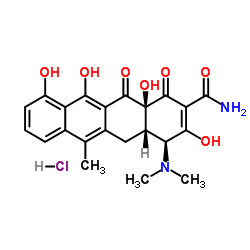Anhydrotetracycline Hydrochloride

Anhydrotetracycline Hydrochloride structure
|
Common Name | Anhydrotetracycline Hydrochloride | ||
|---|---|---|---|---|
| CAS Number | 13803-65-1 | Molecular Weight | 462.880 | |
| Density | N/A | Boiling Point | 618.6ºC at 760 mmHg | |
| Molecular Formula | C22H23ClN2O7 | Melting Point | 222.8ºC | |
| MSDS | USA | Flash Point | 327.9ºC | |
|
Pre-microRNA binding aminoglycosides and antitumor drugs as inhibitors of Dicer catalyzed microRNA processing.
Bioorg. Med. Chem. Lett. 22 , 1709-11, (2012) Over-expressions of miRNAs are being increasingly linked with many diseases including different types of cancer. In this study, the role of some known small molecular therapeutics has been investigated for their ability to bind with the pre-miRNA target (hsa-... |
|
|
Tetracycline repressor allostery does not depend on divalent metal recognition.
Biochemistry 53(50) , 7990-8, (2014) Genes that render bacteria resistant to tetracycline-derived antibiotics are tightly regulated by repressors of the TetR family. In their physiologically relevant, magnesium-complexed form, tetracyclines induce allosteric rearrangements in the TetR homodimer,... |
|
|
Use of mCherry Red fluorescent protein for studies of protein localization and gene expression in Clostridium difficile.
Appl. Environ. Microbiol. 81(5) , 1652-60, (2015) Fluorescent proteins are powerful reporters in biology, but most require O2 for chromophore maturation, making them inherently difficult to use in anaerobic bacteria. Clostridium difficile, a strict anaerobe with a genomic GC content of only 29%, is the leadi... |
|
|
Development and validation of an HPLC method for tetracycline-related USP monographs.
Biomed. Chromatogr. 28(9) , 1278-83, (2014) A novel reversed-phase HPLC method was developed and validated for the assay of tetracycline hydrochloride and the limit of 4-epianhydrotetracycline hydrochloride impurity in tetracycline hydrochloride commercial bulk and pharmaceutical products. The method e... |
|
|
Development of a repressible mycobacterial promoter system based on two transcriptional repressors.
Nucleic Acids Res. 38(12) , e134, (2010) Tightly regulated gene expression systems represent invaluable tools for studying gene function and for the validation of drug targets in bacteria. While several regulated bacterial promoters have been characterized, few of them have been successfully used in... |
|
|
[A precise equilibrium equation for four steps of binding between TBP and TATA-box allows for the prediction of phenotypical expression upon mutation].
Biofizika 55(3) , 400-14, (2010) Among the main events of transcription initiation of TATA-containing genes in eukayotes are the recognition and binding of the TATA-box by the TATA-binding protein (TBP) to start the preinitiation complex formation on the nucleosomal DNA. Using the equilibriu... |
|
|
The bacterial nanorecorder: engineering E. coli to function as a chemical recording device.
PLoS ONE 6(11) , e27559, (2011) Synthetic biology is an emerging branch of molecular biology that uses synthetic genetic constructs to create man-made cells or organisms that are capable of performing novel and/or useful applications. Using a synthetic chemically sensitive genetic toggle sw... |
|
|
Programmable bacteria detect and record an environmental signal in the mammalian gut.
Proc. Natl. Acad. Sci. U. S. A. 111(13) , 4838-43, (2014) The mammalian gut is a dynamic community of symbiotic microbes that interact with the host to impact health, disease, and metabolism. We constructed engineered bacteria that survive in the mammalian gut and sense, remember, and report on their experiences. Ba... |
|
|
A plasminogen-activating protease specifically controls the development of primary pneumonic plague.
Science 315(5811) , 509-13, (2007) Primary pneumonic plague is transmitted easily, progresses rapidly, and causes high mortality, but the mechanisms by which Yersinia pestis overwhelms the lungs are largely unknown. We show that the plasminogen activator Pla is essential for Y. pestis to cause... |
|
|
Identification of a toxic peptide through bidirectional expression of small RNAs.
ChemBioChem. 10(2) , 238-41, (2009)
|